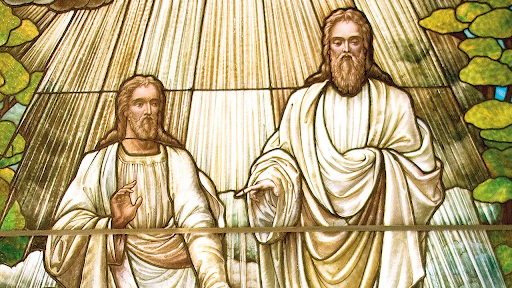
(Image Source: LDS.org)
In the bustling townships of early America, where dreams grew as wild as wheat, a new faith laid down its roots. Some have asked, “Is Mormonism Christian?” Yet the Church of Jesus Christ of Latter-day Saints has ever proclaimed its foundation is set upon Jesus Christ. From the start, Christ has been at its center. This is not a recent theological shift, but a core belief that early leaders have trumpeted from 1830, to the turn of the 20th century, and up to the present day. Yet critics’ voices have loudly proclaimed its unorthodoxy, challenging the idea that this is a Christ-centered faith.
Joseph Smith: The Founding Prophet
From the inception of this American-born faith, Joseph Smith spoke of visions and revelations. In 1830, he brought forth the Book of Mormon. The title page declares its purpose: to convince “Jew and Gentile that Jesus is the Christ, the Eternal God…” This has ever been at the heart of its message, rejecting any assertion that might ask: “Why are Mormons not Christians?”
Yet as Smith unveiled new volumes of scripture, critics have been relentlessly challenging its legitimacy, arguing that adding new texts and revelations deviates–unforgivably–from traditional Christianity.
One early critic, Alexander Campbell, an influential Protestant minister, declared, “The Book of Mormon is a fable, and Joseph Smith is a fraud.” Such statements have fueled the belief among some that the LDS Church is not legitimately Christian.
Smith’s revelations, recorded in the Doctrine and Covenants, emphasize Christ. Doctrine and Covenants 76:22-24 declares, “And now, after the many testimonies which have been given of him, this is the testimony, last of all, which we give of him: That he lives! For we saw him, even on the right hand of God; and we heard the voice bearing record that he is the Only Begotten of the Father.” Despite these affirmations, critics’ voices persisted, questioning the new church’s alignment with Christianity.
Joseph also penned the Articles of Faith. The first article reads, “We believe in God, the Eternal Father, and in His Son, Jesus Christ, and in the Holy Ghost.” Here was the clear affirmation of their beliefs. But critics were relentless. They said these new scriptures and unique doctrines made the church non-Christian.
Brigham Young: Expanding the Vision
Another powerful personality, Brigham Young, took over Church leadership after Smith. He led the saints westward to the Salt Lake Valley, but ever kept the Church’s focus on Christ. In 1860, he said, “The gospel that we preach is the power of God unto salvation, and it is the same gospel that was revealed to Adam, and to Noah, and to Abraham, and to the prophets down to the time of John, who baptized Jesus in Jordan. It is the same gospel that Jesus taught when he was upon the earth, and that was taught by his Apostles.”
Young also spoke of the atonement. “The atonement of Jesus Christ is the foundation of our faith. It is the rock upon which our faith is built,” he declared. But critics voice’s did not fade away, arguing that the Church’s focus on prophets and new revelations represented an irredeemable divide with traditional Christianity.
John Taylor: Defending the Faith
John Taylor, the third Church president, defended the faith with eloquence. In “The Mediation and Atonement,” he wrote, “We believe in Jesus Christ as the Savior and Redeemer of the world; we believe in His atonement and the efficacy thereof; and that through His blood, our sins can be washed away.” Taylor’s words were clear and irrefutable. He viewed Christ’s mission as universal: “Christ came to die for all men, and not for a few,” he said. Yet despite these affirmations, a battle of words has persisted.
Wilford Woodruff: Continuity and Commitment
Wilford Woodruff, the fourth Church president, kept the ship steady. In 1883, he declared, “Jesus Christ, the Son of God, is the center and foundation of our faith. Without Him, we have no hope; with Him, we have every hope.” His words were as firm as the Rocky Mountains. He spoke of following Christ’s example: “We must walk as He walked, and be pure as He was pure. This is the path that leads to eternal life.” These messages are simple, direct, and unmistakable. Yet outside the Church, opponents characterize these teachings as tainted by unique and unfamiliar doctrines that define Latter-day Saints as unfamiliar to the teachings of the Lord and Savior of the world.
Lorenzo Snow: A Personal Testimony
Lorenzo Snow guided the Church into the new century. His testimony of Christ was personal. He recounted a vision: “I saw the Savior standing in front of me… and I shall never forget the smile that covered His face. It filled my whole soul with joy unspeakable.” This vision guided his leadership throughout his leadership tenure.
Snow spoke of Christ’s divine role in salvation: “We must have faith in the Lord Jesus Christ. This is the first principle of the gospel, and it is the foundation upon which all the other principles rest.” Yet, critics claimed the Church’s commitment to works and the construction of temples overshadowed its Christian message.
Persistent Critical Voices
Like Alexander Campbell, critics continue to be vocal in their dismissal of Mormon theology. They choose to emphasize Mormonism’s unique practices and doctrines, referencing these mongrel ideas to keep people hyper focused on the idea: Are Mormons Christian?
Understandably, such persistent voices have shaped public perception. Yet, within the Church itself, the focus on Christ remains unwavering.
What Remains
From Joseph Smith to Lorenzo Snow, the LDS Church’s early leaders never wavered in their emphasis on Jesus Christ. They consistently declared the Savior’s divinity, taught His atonement, and urged followers to live as Christ did. Despite persistent critics and their insistence that an ongoing battle of Mormonism VS Christianity rages, the core message of the LDS Church has not changed, has not altered, and continues to celebrate the incomparable divinity of Jesus Christ.
LDS Church teachings about Jesus and His mission are deeply embedded–irreversibly so–and the earliest statements of Mormon leaders reaffirm this eternal commitment to Him. A focus on Christ has been the guiding light throughout the Church’s mortal and eternal mission. Critics may continue to debate the minutiae, but for faithful members, Christ is the cornerstone–the centerpiece–and ever will be until the day of His glorious Second Coming.

Fact Checked by Mr. Kevin Prince, Source Expert
Kevin Prince is a religious scholar and host of the Gospel Learning Youtube channel. His channel has garnered over 41,000 subscribers and accumulated over 4.5 million views. Mr. Prince also created the Gospel Learning App, a reliable platform where individuals seeking truth can access trustworthy answers to religious questions from top educators worldwide.
About Mormonism Explained
Mormonism Explained is a resource that was designed to provide objective and factual information about Mormonism, its history, doctrines, and policies. Our team of researchers consults experts and primary sources to present factual information on a variety of topics relevant to the Mormon Church.
Tags

